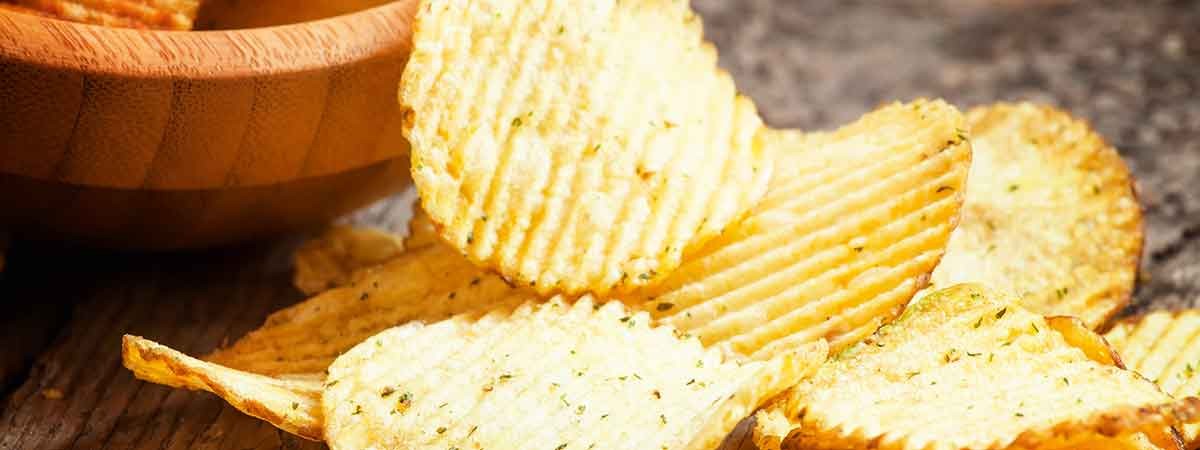Less fat and less acrylamide – chips fried in a vacuum are healthier. They also taste great, as the lower temperatures protect the natural flavours.
Hot oil or fat is used to deep fry food. For this process to succeed, it is key that the frying oil is hot enough to quickly evaporate the moisture in the food being deep-fried. After all, that is the only way to quickly create those distinctive fried flavours and delicious crust. However, as the temperature increases, so does the level of harmful acrylamide. Deep-frying in a vacuum resolves this dilemma: because the boiling point of water is lower in a vacuum, it is possible to reduce temperatures without impacting the taste and consistency of the end product.
Water vapour prevents the intrusion of fat
The temperature at which food – for example a potato crisp – is deep-fried has a significant impact on its subsequent fat content. On contact with hot oil, the water evaporates out of the crisp. The water vapour flows against the fat and prevents it from intruding. However, if the oil is not hot enough, the flow of steam created is much weaker, meaning that significantly more fat is able to enter the cooked food. The second fat barrier is also related to temperature: once the water on the surface of the deep-fried food is completely evaporated, the "Maillard reaction" begins, forming a delicious crust. The quicker this happens, the less fat is absorbed.
The vacuum fryer performs its work at a rough vacuum of around 100 mbar, in which water evaporates at around just 70 instead of 100 degrees. Formation of a crust also starts at a lower temperature than in traditional devices. While the oil for deep-frying needs to reach up to 170 to 185 degrees at atmospheric pressure, in a vacuum, a temperature of 140 degrees is sufficient. As a result, the fat content of deep-fried food is significantly reduced; potato crisps, for example, can contain approximately 17% fat rather than the usual 35%.
Higher temperatures produce more acrylamide
A few years ago the general public became conscious of acrylamide, a chemical compound that was discovered in deep-fried foods. Made up of sugar and the protein building block asparagine, it is created when high-carbohydrate foods are subjected to very high temperatures. Although press reports at the time talked about chips in particular, all potato and grain products – and therefore also deep-fried coatings – in principle also fall into this category. Acrylamide is suspected to increase the risk of cancer. The substance forms in particularly large quantities at temperatures of 180 degrees or more. The acrylamide content of many deep-fried foods can be significantly reduced by lowering the cooking temperature. So potato crisps – when cooked at a maximum of 140 degrees in a vacuum – contain up to 95% less acrylamide than nibbles produced at normal pressure.
Delicious and crispy
However, vacuum frying doesn't just make products healthier, but also tastier: the natural flavours of ingredients are protected by lower cooking temperatures, and the taste is more intense. The colour of the crisps is also more natural, and the crust crispier. What's more, the cooking oil used stays fresh for longer at lower temperatures, and even costly unrefined vegetable oils with a low smoke point can be used.

Healthier nibbles
Deep frying in a vacuum reduces cooking temperature
What kind of crisps is vacuum frying best for?
Vacuum fryers were used for the first time at the end of the 1960s, to create crisps from potatoes which had been stored from the previous year. The particularly high starch content of these potatoes meant that deep-frying them under atmospheric conditions resulted in something black and inedible. However, with reduced cooking temperatures enabled by a vacuum, it was possible to process this old stock.
Sweeter potatoes increase the importance of a vacuum
Today, vacuum processes for making crisps are generally used for high quality products. For example, this method is often employed for organic crisps. As organic potatoes must not be treated with pesticides, they are generally harvested earlier in order to protect against pests. As a result, they often have a higher sugar content than conventional potatoes: the sweeter the potatoes, the greater the risk of acrylamides forming during deep-frying. This means that sugar-rich food particularly benefits from the fact that vacuum frying is performed at lower temperatures. In addition to organic potato crisps, this process is used to produce other products, such as vegetable or fruit crisps.
Vacuum fryers were used for the first time at the end of the 1960s, to create crisps from potatoes which had been stored from the previous year. The particularly high starch content of these potatoes meant that deep-frying them under atmospheric conditions resulted in something black and inedible. However, with reduced cooking temperatures enabled by a vacuum, it was possible to process this old stock.
Sweeter potatoes increase the importance of a vacuum
Today, vacuum processes for making crisps are generally used for high quality products. For example, this method is often employed for organic crisps. As organic potatoes must not be treated with pesticides, they are generally harvested earlier in order to protect against pests. As a result, they often have a higher sugar content than conventional potatoes: the sweeter the potatoes, the greater the risk of acrylamides forming during deep-frying. This means that sugar-rich food particularly benefits from the fact that vacuum frying is performed at lower temperatures. In addition to organic potato crisps, this process is used to produce other products, such as vegetable or fruit crisps.